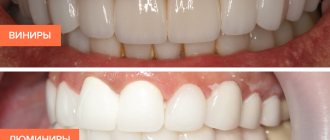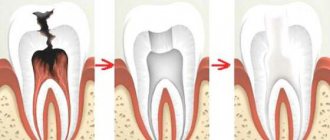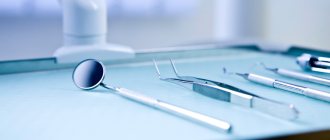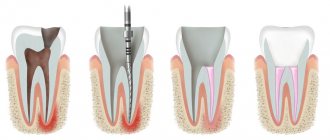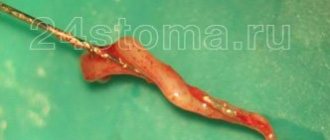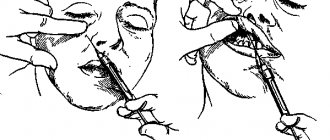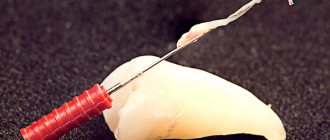Depulpation is a complex dental procedure that is not always successfully performed even in a clinic, not to mention nerve removal at home. The procedure is used in rare cases, for example, in cases of deep damage to dentin by carious processes or inflammation of the soft tissues of the tooth. The nerve endings are located in the pulp, which has a fibrous, loose structure. It is in this area that there is a nerve and a network of intertwined blood vessels through which nutrition is carried out.
After removal of the nerve, the tooth becomes more vulnerable to infectious pathogens. Gradually it darkens and loses its original strength characteristics. For this reason, before proceeding with depulpation, you need to make sure that this procedure is really necessary.
Indications for the procedure
Let's consider the main list of indications for the operation:
- Deep caries. Dentists advise patients to visit the clinic at least once every 6 months in order to identify and treat caries in the early stages of development. When only the enamel is affected, in 90% of cases it is possible to preserve the nerve endings of the tooth. The carious cavity can grow over several months and reach the dentin and pulp. In the latter case, a procedure to remove the nerve cannot be avoided.
- Unsuccessful dental treatment in the past. When removing tooth tissue damaged by caries, the doctor may accidentally open the pulp chamber. In this case, it will be important to remove the nerve to prevent the development of pulpitis under the filling. Amputation in this case can be complete or partial.
- The need for prosthetics. Typically, to restore the integrity of the row, prostheses are used that are attached to supporting units. The installation technology of most permanent structures involves depulping the elements that are considered as support. The procedure is necessarily carried out for teeth that are located at an angle.
- Serious mechanical damage to tooth tissue. Among the consequences of injuries are deep chips that affect the nerve endings of the teeth. In such cases, the damaged unit can rarely be saved, especially if we are talking about the front teeth. If the extreme molars are injured, then only partial depulpation is possible.
One of the main signs of incipient pulpitis is acute pain in the tooth of a vague nature. In rare cases, the disease becomes chronic and does not manifest itself with characteristic clinical signs. Only a dentist can accurately determine the presence of pulpitis using a thorough visual examination and temperature tests. If the doctor insists on depulpation, then you should not refuse the operation.
Causes of inflammation
The main cause of nerve inflammation is infection . Factors influencing the spread of infection into the pulp include:
- caries in advanced form . The combination of poor hygiene, microbes and dentin decay products leads to loosening of the tooth surface structure. Pathogenic bacteria penetrate into the cavity through microcracks and dentinal tubules, causing inflammation of not only the pulp, but also the periodontium;
- damage from mechanical impact . A common cause of inflammation is tooth fracture. The infection easily penetrates through the exposed part of the dentin;
- poor quality dental treatment . The development of pulpitis can be facilitated by poor aseptic processing or the presence of pieces of hard tooth tissue remaining after the formation of a cavity for cleaning the canals and filling.
Symptoms requiring nerve removal
At home, several tests will help determine whether the tooth nerve needs to be removed. The first symptom is prolonged toothache, which intensifies when eating or turning the head. The intensity of the symptom increases at night, when the person assumes a horizontal position. People with pulpitis find it difficult to sleep without painkillers.
At home, you can do a cold test to determine pulpitis. To do this, cool a cotton ball in the freezer and touch it to several teeth located in the painful area. Typically, the affected unit does not react to cold immediately, but over time.
Aching pain may also indicate the need to visit a doctor. In this case, unpleasant signs appear only under the influence of various irritants - heat, cold, acids. Discomfort persists for some time after eliminating the irritating factor.
Diagnosis of the disease
Diagnosis of the disease is one of the most important stages, since correct diagnosis is the key to successful treatment. The main way to diagnose pulpitis is an x-ray examination, thanks to which it is possible to accurately determine the degree of tooth damage and the nature of inflammation. Also, the dentist can conduct electroodontodiagnosis of the tooth (EDD). This procedure is carried out to test the reaction of the tooth pulp to electric current. How the test is carried out: To carry out EDI, an electrodontometer device is used, which has active and passive electrodes. The specialist places the active electrode on the sensitive area of the tooth, while the passive electrode remains in the patient’s hand. The current is supplied with varying strengths in order to understand at what stage the tooth will begin to react to it. The stronger the inflammatory process, the greater the current required for the tooth to react and cause discomfort. The norm is 2-6 µA, readings of 60-90 µA indicate the presence of pulpitis, periodontitis is determined by a current strength above 100 µA.
Preparation before home depulpation
At home, you can kill the nerve of the tooth or reduce its sensitivity. In the first case, you will have to destroy the crown part of the tooth to get to the problem area.
Before suppressing the sensitivity of the structure, the following preparatory measures are performed:
- Decide whether it is necessary to kill the dental nerve or reduce its susceptibility to external irritants. The method of relief will depend on the intensity of the pain and the qualifications of the person who will carry out emergency measures.
- Treatment of the oral cavity with antiseptics.
- Cleaning the canals with a needle. It is preheated over a fire and treated with disinfectants, for example, Miramistin or Chlorophyllipt.
- Repeated antiseptic treatment of the mouth.
Why is nerve removal performed?
Long-term progressive pulpitis can ultimately lead to psychological disorders. This is due to the fact that a person constantly has to endure intense pain. Other complications of untimely intervention include:
- flux;
- osteomyelitis;
- periodontitis;
- dental granuloma;
- tooth loss.
Periodontitis is one of the dangerous complications of pulpitis
If the tooth has collapsed under the crown, the corrective device is removed and the element underneath is healed. The material of the prosthesis or crowns has better thermal conductivity than dentin and enamel. For this reason, severe cramps may occur when eating cold or hot food.
Complications
When carrying out such a procedure, complications may arise, caused by both the dentist and the patient himself. Medical errors that cause complications include:
- breakage of the extractor in the channel . Occurs as a result of using low-quality tools or using too much force during removal;
- bleeding from the canal , which can be caused by excessive tissue trauma that occurs when the pulp is torn off;
- the occurrence of inflammation due to incomplete removal of necrotic tissue, which is characterized by severe pain and can lead to complete loss of the tooth.
Complications caused by the patient themselves include the following:
- residual pulpitis;
- periodontitis.
Find out what complications can occur after tooth extraction if the doctor made a mistake.
Instructions on how to stop bleeding after tooth extraction are in this section.
What to do if your gums hurt after tooth extraction? Read https://zubovv.ru/hirurgiya/udalenie-zubov/chto-nado-delat-esli-posle-bolit-desna.html here.
Suppression of nervous sensitivity at home
In life, there are often situations when a tooth hurts, and it is not possible to see a doctor in the near future. Toothache is difficult to endure even with the help of powerful painkillers.
To reduce the intensity of signs of pulpitis, you can use proven folk remedies:
Tooth depulpation before prosthetics
- Comfrey tincture: 2 tsp. the plant component is poured with 50 ml of alcohol and left for 10 days. A cotton swab soaked in the solution is applied to the problem area.
- Soda solution. In 1 tbsp. l. boiled water stir 1 tsp. soda and 1 tsp. salt. Rinse your mouth with the product after each meal. Salt helps suppress the activity of pathogenic flora in the mouth, and soda reduces the severity of soft tissue swelling.
- Propolis-based tincture: 1 tbsp. l. crushed plant component is poured into 100 ml of 70% alcohol and left in a dark place for 10 days. Apply a cotton swab soaked in the product to the diseased tooth for 15 minutes.
- Hydrogen peroxide. The drug with a concentration of 3% is dissolved with water in a ratio of 2:1. The moistened cotton wool is applied to the problem tooth. The product can also be used as a mouth rinse.
- Onion peel, which has a powerful disinfecting effect: 3 tbsp. l. husks are poured with 500 ml of water and put on fire. After boiling, the drug is infused for 40 minutes and used to rinse the mouth 5-6 times a day.
- Herbal tincture. To create the medicine, take chamomile, thyme, lemon balm and mint. Herbs are taken in equal proportions and 500 ml of boiling water is poured. The decoction should be used warm (not hot). Otherwise, the severity of the inflammatory process near the problematic tooth may increase.
- Garlic. The vegetable is ground with salt and applied to the problem area for 15-20 minutes.
Removing dental nerves at home
Before you begin to destroy the nerve endings in the tooth, you should thoroughly clean the oral cavity of plaque and food debris. If this rule is ignored, suppuration may develop in the treated tooth.
Emergency measures carried out at home threaten human life, so they must be carried out with caution. How can you kill a nerve? Several methods of getting rid of pulp should be noted:
- Arsenic. The procedure uses pastes that contain arsenic compounds. It is prohibited to use the component in its pure form, as it is a potent poison and can cause poisoning. If more than 5 ml of arsenic is ingested, death occurs.
- Zinc. You can obtain the substance at home using newspapers. Zinc is found in printing ink. A newspaper with a large number of images is placed on a plate and set on fire. The resulting ash is collected with cotton wool and placed in a previously cleaned channel. The affected element is covered with another cotton swab.
- Vinegar essence. A small piece of cotton wool is dipped into vinegar with tweezers and applied to the sore tooth. It is very important that a piece of cotton wool does not come into contact with the mucous membranes of the mouth. Otherwise, soft tissue burns may occur.
If the preparatory measures and the nerve removal itself are carried out correctly, the pain will subside within a few hours. The danger of self-treatment lies in the fact that poorly treated canals can cause further spread of infection. You should visit a doctor in the coming days even if there is no pain in the tooth. It is not possible to drill out all the caries on your own.
To prevent tooth infection before visiting a doctor, you should regularly rinse your mouth with oak bark tincture and diluted aloe juice.
To disinfect the oral cavity after self-depulpation, you can use honey wax honeycombs. They are chewed after each meal.
What to do after tooth depulpation
In the first few days, if pain occurs in pulpless teeth, you should use anti-inflammatory non-steroidal drugs:
- Ketanov. The effect of taking the drug is observed after 30 minutes, the effect of the medicine lasts for 5-6 hours. The product has many contraindications and side effects, so you should not get carried away with its use.
- Analgin. Can be used for toothache if it is not too intense. Relief from the condition after taking the medicine occurs quickly (within 15-20 minutes). Instead of Analgin, you can use Baralgin. It is able to relieve low-intensity aching pain in a tooth for a long time.
- Pentalgin. Used in cases where inflammatory complications after dental treatment are involved.
- Novalgin is an anesthetic with a pronounced anti-edematous effect. The effect of using the drug is observed within 15 minutes.
Medicines
In order to kill the nerve, several types of drugs are now used. Most of them are based on arsenic or formaldehyde .
In dentistry, the process, the essence of which is to kill the pulp and, accordingly, the nerves, is called devitalization.
Arsenic paste
There are several such pastes successfully used by dentists. They differ in the percentage of main components, sometimes in their number and names.
DEVIT-ARS
This is a ready-made material for completely painless and fairly quick devitalization . The main component is arsenic anhydride. There is about a third of it in the preparation. It ensures the start of the necrosis process and its non-aggressive course.
In order to reduce or completely remove pain by reducing tissue sensitivity, lidocaine hydrochloride is added to the drug.
During the process of necrosis, it is necessary to carefully monitor so that infection does not enter the cavity and inflammation does not begin. Therefore, Devit-ARS also contains broad-spectrum antiseptics - metacresol, eugenol, chlorophenol.
Depending on the complexity of the structure of the tooth itself, the entire process can take from one to two days.
The drug is available in two forms. The first is the actual paste (3 grams) in a syringe tube. In this case, a special paste former and fibrous filler are also introduced into the composition. This is necessary for the softness and plasticity of the finished paste for easy application. The second is 100 unidoses of 4 milligrams.
Kaustinerv Rapid
The drug is supplied in containers (plastic jars) of 6.5 grams. Its composition is somewhat different from Devit-ARS. Per 100 g of excipient (a substance that, in fact, is a conductor) accounts for 30%, that is, 30 g, as in the previous case of arsenic anhydride.
It also contains 28.5 g of lidocaine base, 4 g of menthol, 2 g of ephedrine hydrochloride and 20 g of phenol.
The drug is placed as close as possible to the area that is subject to devitalization. The thicker the layer of dentin on top, the slower the effect of the medicine. Usually three or two days are enough.
There are some other drugs that, in their composition and action, are practical analogues of the two described above - Septodont, Pulparsen, Causticin .
Some may also contain, in addition to antiseptics (camphor, thymol or carbolic acid), arsenic anhydride and anesthetics (lidocaine hydrochloride, novocaine, dicaine), tannin. It is an astringent, and therefore serves to prolong the effect of the medicine.
Devitalizing arsenic-free pastes
Patients may find that these drugs have a significant disadvantage - they take longer to act than their harsher counterparts containing arsenic anhydride. However, the period increases by only a few days, and such drugs do not cause any harm to the body.
One example is Devit . There are two release options - Devit-P and Devit-S, which are intended for devitalization. Depending on the situation, the dentist can name the subtleties of use in each specific case.
Devit-P
The actual devitalization is provided by a strong antiseptic – paraform, which coagulates albumins. Lidocaine hydrochloride is a local anesthetic. Camphor, menthol, chlorophenol - further increase the antiseptic effect.
Effective sterilization, which occurs due to the action of the drug, makes it possible to do without complete removal.
Devit-S
The anesthetic and main active ingredient is paraformaldehyde, which reduces and eliminates pain. Lidocaine hydrochloride also acts as an anesthetic component, and creosote provides the antimicrobial effect of the drug.
Devitalization occurs over a longer period of time, but is completely painless . In addition, after using Devit-S, there is no need, as in the case of using preparations based on arsenic anhydride, to carry out additional processing and neutralize arsenic salts in the channels.
The dentist prescribes one of the drugs, considering each case separately. Arsenic-free pastes are used when treating children or when other treatment is contraindicated.
The duration of action of each medicine is slightly different. Preparations based on arsenic salts act several days faster than their arsenic counterparts.
Precautionary measures
To prevent folk remedies for toothache from harming your health, you should follow several basic rules:
- do not swallow mouthwash;
- avoid contact of antiseptic solutions with eyes;
- do not keep medications in your mouth for too long;
- follow the dosage of medications indicated in the instructions.
The effectiveness of home remedies for pulpitis is questionable, since a person himself will not be able to clean and fill the dental canals. Among the complications that arise during treatment at home, the following should be noted:
- burn of mucous structures;
- inflammation of the soft tissues of the mouth;
- poisoning.
Depulpation in a clinical setting
The procedure is most often painless, since before it the patient is injected into the gums with modern anesthetic drugs. It is possible to heal a diseased tooth in one visit to the dentist without using products containing arsenic.
Stages of the dental depulpation procedure:
- puncturing the gums located next to the diseased element with anesthetics;
- expansion of the channel 15 minutes after drug administration;
- treatment of the oral cavity with disinfectants;
- removal of the nerve using special dental equipment;
- repeated mouth antiseptics and filling of the root canal of the pulpless element.
If there are any problems with the operation, the dentist will heal the tooth according to a different scheme. After cleaning the canals, a medicine is placed into the carious cavity, which has an effect similar to arsenic, but is less dangerous for humans. After complete removal of the nerve endings, the doctor performs secondary cleaning of the canals. Permanent composite material is installed only after complete destruction of the nerve and cleansing of the canals from necrotic masses.
After the intervention, soreness of the unit and swelling of the soft tissues near it can be observed for 2-3 days. If the problem is accompanied by acute throbbing pain and fever, you should immediately consult a doctor again.
Treatment of pulpitis without pain - a modern standard in dentistry
Today it is possible to save a diseased tooth, even without causing additional suffering to exhausted patients. Before starting the procedure, the dentist performs an application of anesthesia, and after it - an anesthetic injection that is no longer even felt by the patient. Effective modern anesthetics allow you to calmly remove the affected tissue and, using special devices, remove the inflamed pulp from the canals without disturbing the patient’s comfort.
Then the channels are expanded along their entire length, washed with antiseptics and formed for further filling. In severe cases, a medicine is placed in them for a certain period of time to prevent infection, and the tooth is closed with a temporary filling. When the situation is extremely advanced, it may be necessary to prescribe and ingest drugs that suppress the activity of the infection. During a subsequent visit, when the doctor is convinced of the proper quality of pulp removal, a permanent filling will be installed.
The use of reliable local anesthesia allows you to almost completely “turn off” tooth sensitivity and guarantee the absence of pain during the procedure. But, at the request of the patient, dental treatment can be performed under sedation . At the same time, a competent dentist will definitely take into account the patient’s existing contraindications to the use of general anesthesia and choose the optimal method of pain relief.
- Promotion
Dental treatment under anesthesia
Promotion for sedation in Moscow!
If you experience: — Severe stress during dental treatment — Fear of the sound of dental instruments — Time-limited visits to the dentist
old price
12 000 ₽
price
5 900 ₽
Free consultation RUB 5,900 for 30 minutes
Limited offer. Sign up for a free consultation. There are contraindications, consultation with a specialist is required.
- Promotion
Teeth whitening ZOOM
Promotion for teeth whitening in Moscow!
As a gift: - Prof. Oral hygiene – Whitening care set with individual trays
old price
40 000 ₽
price
19 900 ₽
Free consultation Sign up for a free consultation. There are contraindications, consultation with a specialist is required.
Answer-question section
Is it painful to perform depulpation?
In dentistry, powerful local anesthetics are used that completely block discomfort during the intervention. Severe pain may be felt if the drug is not suitable for the patient or was administered in the wrong dosage. Without pain relief, the process of treating a carious cavity is very painful.
Why do gums hurt after depulpation?
During the procedure, nerve endings are damaged. Because of this, pain persists for 2-3 days after the intervention. If the doctor performed all the manipulations correctly, the intensity of discomfort decreases, as a rule, by 2-3 days.
Is it possible to perform the procedure for free?
In public medical institutions, the procedure for removing the dental nerve is provided free of charge under the compulsory medical insurance policy. A separate additional payment for the administration of pain medication is possible.
conclusions
It’s not for nothing that there are so many clinics where patients receive qualified care. Thirty percent of people who go to the dentist with extensive and advanced inflammation could minimize the damage if they contacted the dentist in a timely manner. Self-medication can result not only in wasted patient time, but also in large financial expenses.
It is possible to kill the dental nerve at home, but it is an extremely risky activity. It will be easier to avoid many problems if you maintain oral hygiene, visit a doctor on time, and, if possible, do not self-medicate.
